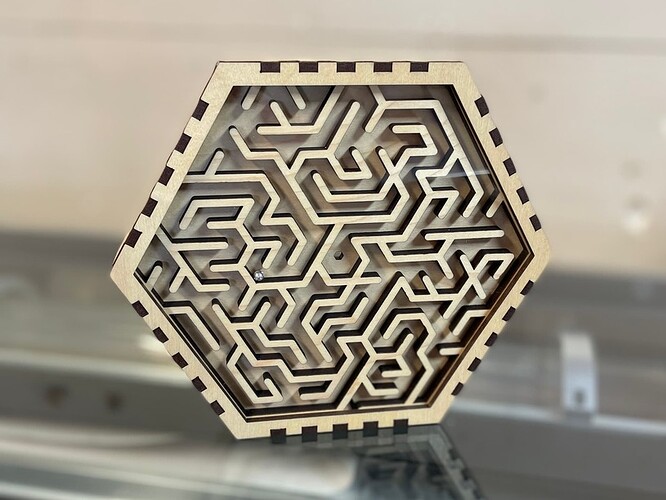A post here from a few months back got me fiddling around with mazes… after a few prototypes (and a lot of “too busy for crafting” weeks) I came up with a version I’m pretty happy with.
The general recipe goes something like this:
-
Two mazes from mazegenerator.net. Tip: turn on showing the solution to the maze and re-generate a few times till you get one you like. I figure a maze toy like this benefits from having a solution path that winds its way around instead of taking a more direct path.
-
Some stroke and boolean operations in Affinity Designer to make a solid piece for the walls of the maze. Note the cutout at the top — that’s the “start” placed by the maze generator, which is the same for both mazes.
-
Material sandwich! The two mazes are
 Thick plywood, about 5mm thick, which gives enough room for the ~4mm bead to roll when sandwiched between two solid pieces. In between the two mazes goes a piece of
Thick plywood, about 5mm thick, which gives enough room for the ~4mm bead to roll when sandwiched between two solid pieces. In between the two mazes goes a piece of  Medium ply, with two holes cut through — one smaller than the bead, so it has a place to rest when you solve the maze and get it to the center, and one larger so the bead can fall between the two maze layers at the “start” point.
Medium ply, with two holes cut through — one smaller than the bead, so it has a place to rest when you solve the maze and get it to the center, and one larger so the bead can fall between the two maze layers at the “start” point. -
Windows: to keep the overall thickness down, I used thinner-than-PG clear acrylic from the scrap bin at my local TAP Plastics. (Probably about 1mm.) It’s supposed to be laser safe, but it sure stinks more than PG does when cutting. Maybe I’ll try instructables next time, or maybe PG will eventually have Thin acrylic…
-
Keeping it together: a hexagonal friction-joint box from the boxes.py generator, with a little bit of tweaking so that the top and bottom pieces have a cutout that lines up with the maze walls. To make sure I got a solid fit, I cut the rest of the pieces and clamped them together before measuring a thickness/height to use for the generator. (And made sure the “radius” for the generator is a tight match for the maze/wall/window sandwich.)
And that’s it — holds together pretty solidly with no glue. The 6- and 11-year-olds approve, so maybe we’ll have to make more sometime. I’d submit it to the gallery, but a) there’s the non-PG material for the windows, and b) what fun is it if everyone’s making the exact same maze? ![]()






